E-LEARNING Report: Management and Organizations in E Global
VerifiedAdded on 2020/03/04
|7
|1261
|64
Report
AI Summary
This report, focusing on E-LEARNING, delves into the application of Taylor's scientific management theory, particularly its relevance in contemporary business environments across Australia, America, and Europe. It explores the theory's influence on call centers and other industries, highlighting modifications needed for optimal outcomes. The report also examines the dynamic nature of organizational culture, comparing various definitions and emphasizing the importance of adaptability, with a preference given to Abdi Osman Jama's perspective, which views culture as constantly evolving. The report concludes that Taylor's principles, with proper adaptation, remain effective, and that organizational culture must be flexible to survive in a changing world. References include sources on Taylorism, cultural psychology, and organizational culture.
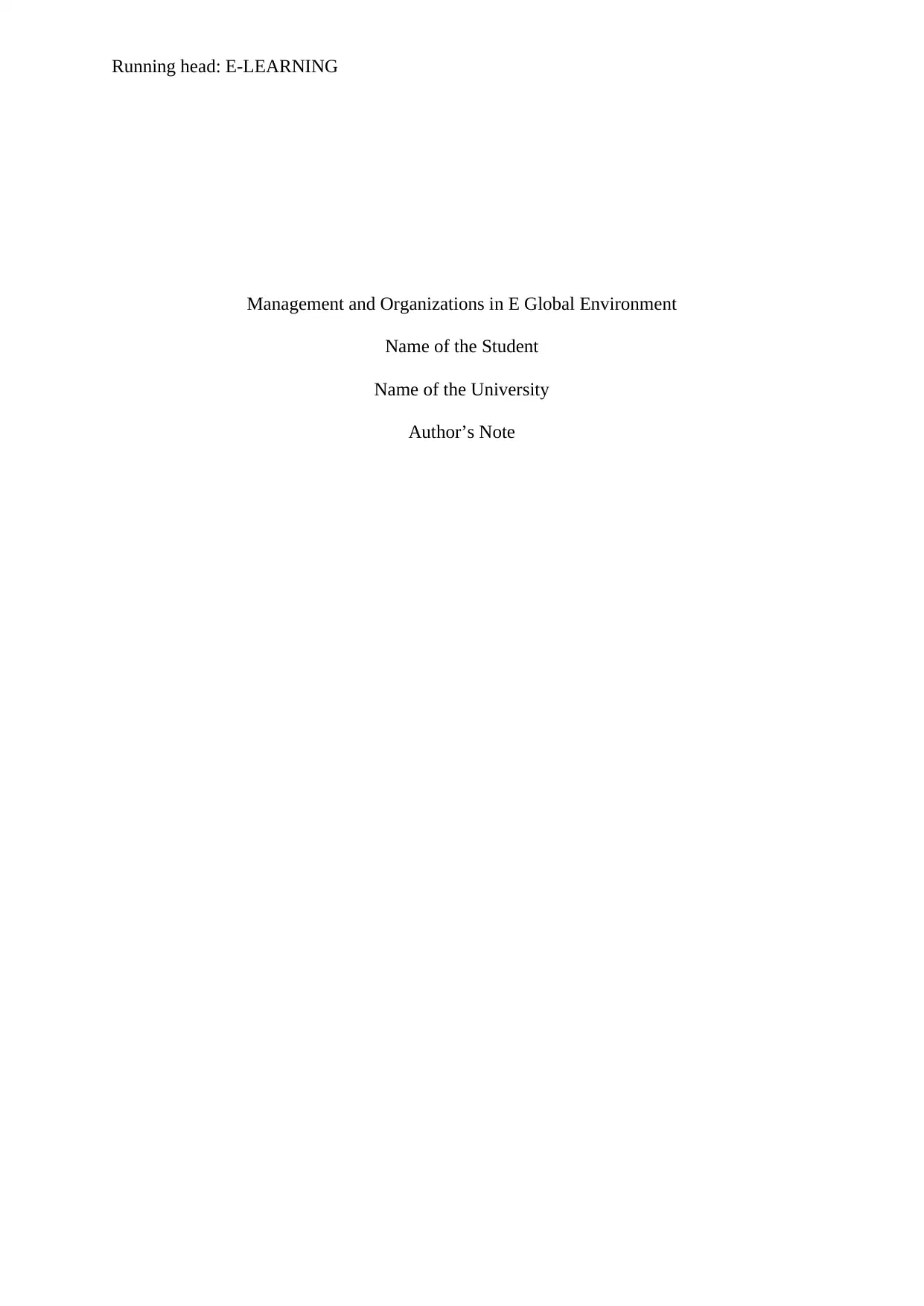
Running head: E-LEARNING
Management and Organizations in E Global Environment
Name of the Student
Name of the University
Author’s Note
Management and Organizations in E Global Environment
Name of the Student
Name of the University
Author’s Note
Paraphrase This Document
Need a fresh take? Get an instant paraphrase of this document with our AI Paraphraser
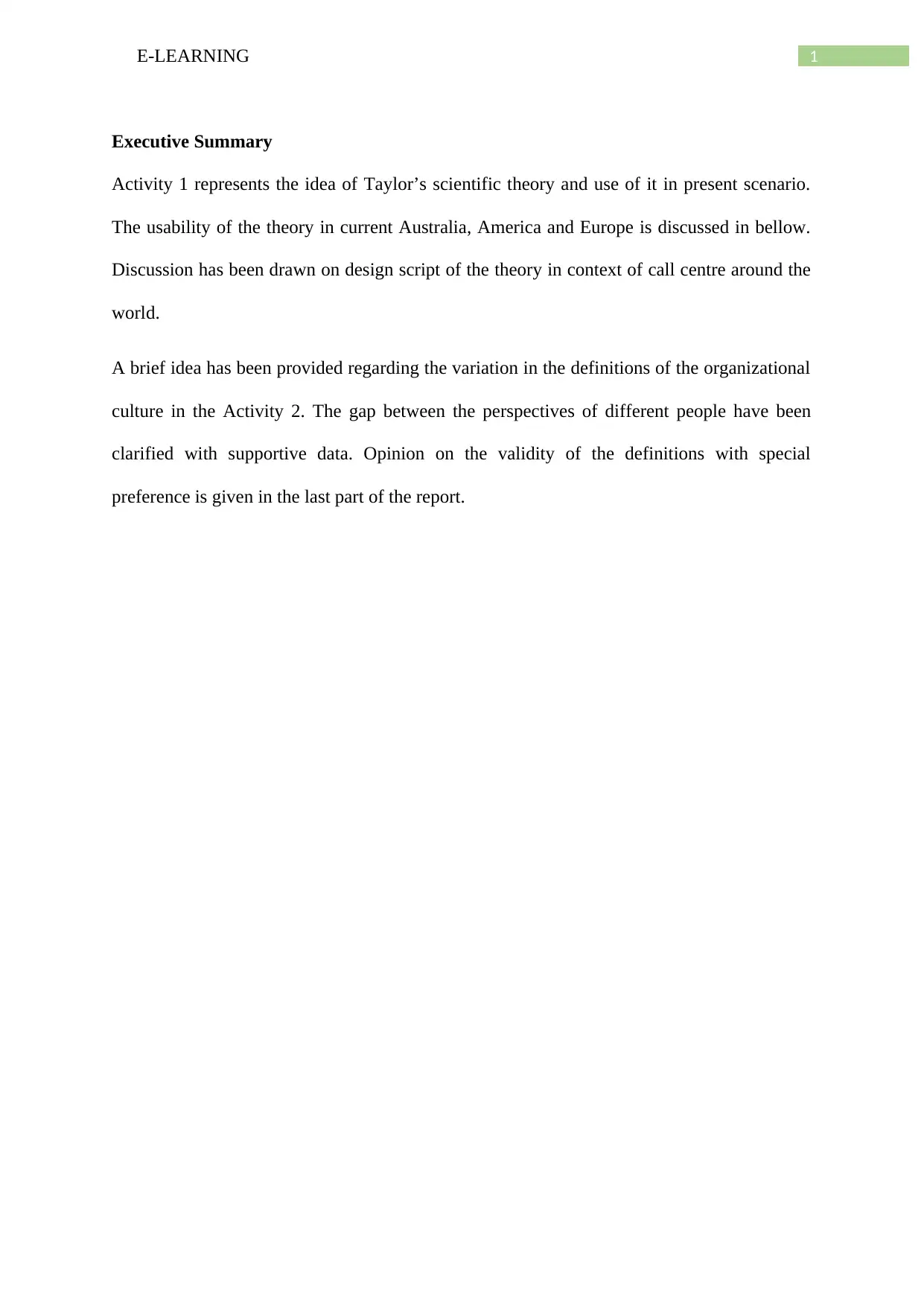
1E-LEARNING
Executive Summary
Activity 1 represents the idea of Taylor’s scientific theory and use of it in present scenario.
The usability of the theory in current Australia, America and Europe is discussed in bellow.
Discussion has been drawn on design script of the theory in context of call centre around the
world.
A brief idea has been provided regarding the variation in the definitions of the organizational
culture in the Activity 2. The gap between the perspectives of different people have been
clarified with supportive data. Opinion on the validity of the definitions with special
preference is given in the last part of the report.
Executive Summary
Activity 1 represents the idea of Taylor’s scientific theory and use of it in present scenario.
The usability of the theory in current Australia, America and Europe is discussed in bellow.
Discussion has been drawn on design script of the theory in context of call centre around the
world.
A brief idea has been provided regarding the variation in the definitions of the organizational
culture in the Activity 2. The gap between the perspectives of different people have been
clarified with supportive data. Opinion on the validity of the definitions with special
preference is given in the last part of the report.
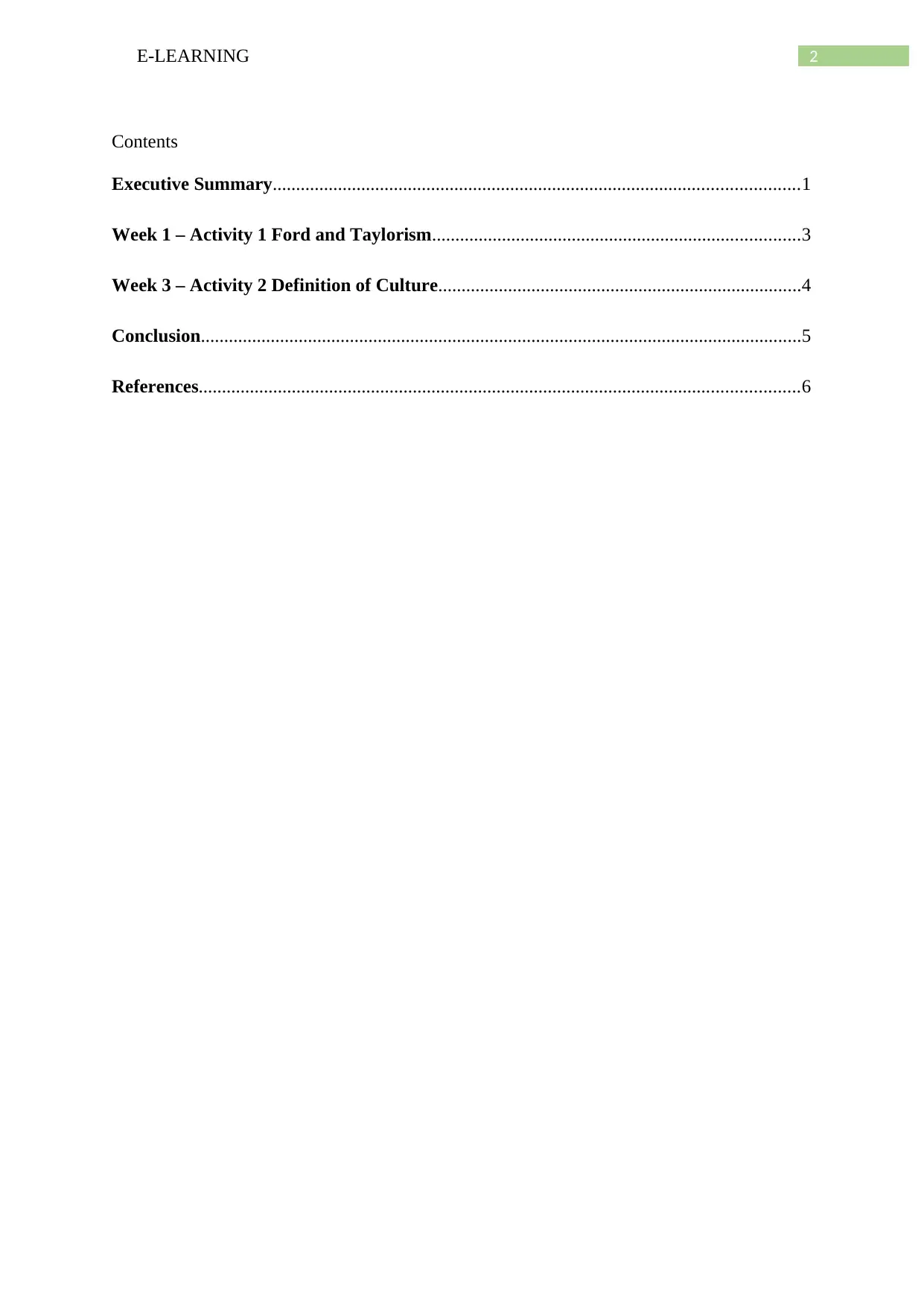
2E-LEARNING
Contents
Executive Summary.................................................................................................................1
Week 1 – Activity 1 Ford and Taylorism...............................................................................3
Week 3 – Activity 2 Definition of Culture..............................................................................4
Conclusion.................................................................................................................................5
References.................................................................................................................................6
Contents
Executive Summary.................................................................................................................1
Week 1 – Activity 1 Ford and Taylorism...............................................................................3
Week 3 – Activity 2 Definition of Culture..............................................................................4
Conclusion.................................................................................................................................5
References.................................................................................................................................6
⊘ This is a preview!⊘
Do you want full access?
Subscribe today to unlock all pages.

Trusted by 1+ million students worldwide
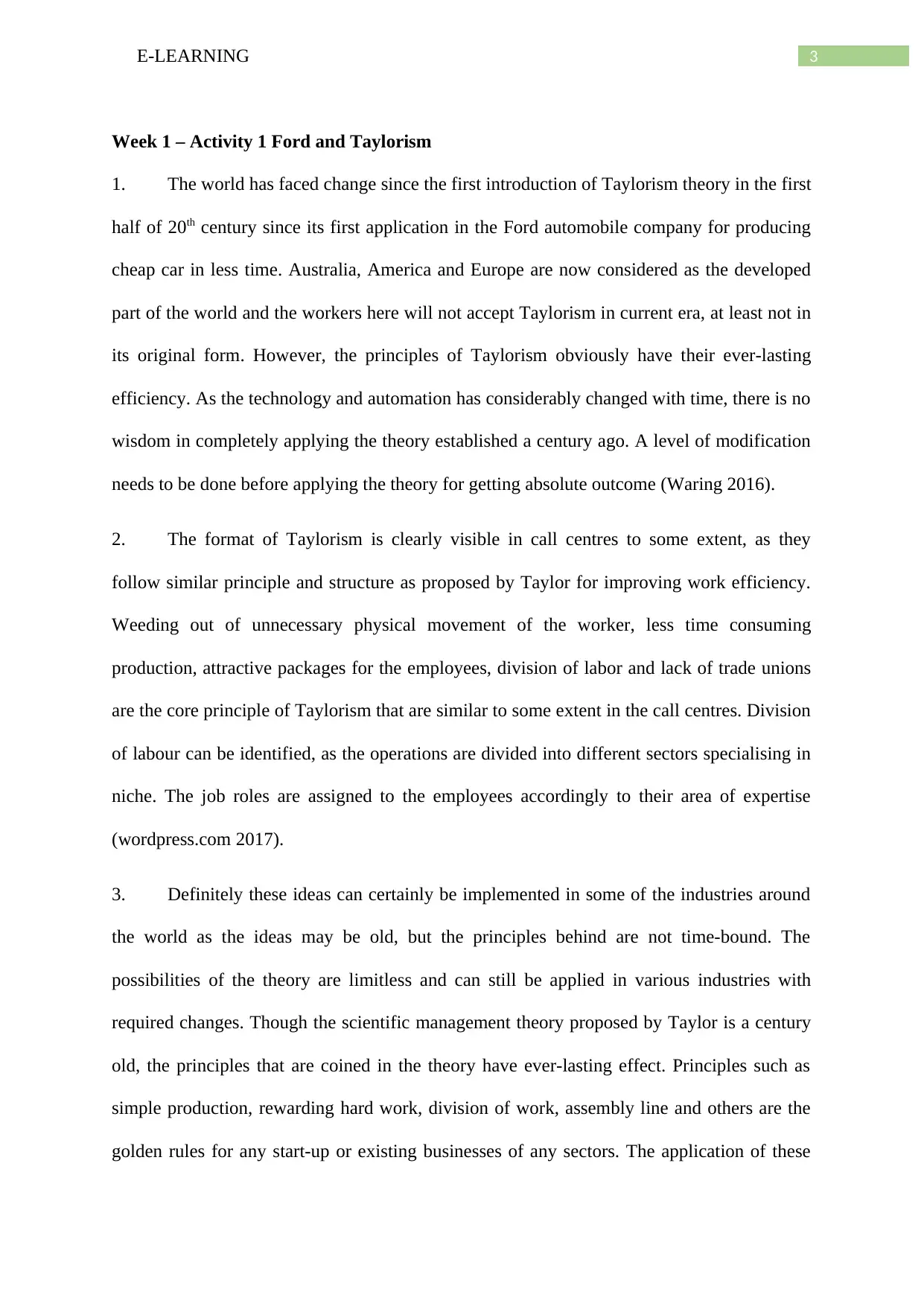
3E-LEARNING
Week 1 – Activity 1 Ford and Taylorism
1. The world has faced change since the first introduction of Taylorism theory in the first
half of 20th century since its first application in the Ford automobile company for producing
cheap car in less time. Australia, America and Europe are now considered as the developed
part of the world and the workers here will not accept Taylorism in current era, at least not in
its original form. However, the principles of Taylorism obviously have their ever-lasting
efficiency. As the technology and automation has considerably changed with time, there is no
wisdom in completely applying the theory established a century ago. A level of modification
needs to be done before applying the theory for getting absolute outcome (Waring 2016).
2. The format of Taylorism is clearly visible in call centres to some extent, as they
follow similar principle and structure as proposed by Taylor for improving work efficiency.
Weeding out of unnecessary physical movement of the worker, less time consuming
production, attractive packages for the employees, division of labor and lack of trade unions
are the core principle of Taylorism that are similar to some extent in the call centres. Division
of labour can be identified, as the operations are divided into different sectors specialising in
niche. The job roles are assigned to the employees accordingly to their area of expertise
(wordpress.com 2017).
3. Definitely these ideas can certainly be implemented in some of the industries around
the world as the ideas may be old, but the principles behind are not time-bound. The
possibilities of the theory are limitless and can still be applied in various industries with
required changes. Though the scientific management theory proposed by Taylor is a century
old, the principles that are coined in the theory have ever-lasting effect. Principles such as
simple production, rewarding hard work, division of work, assembly line and others are the
golden rules for any start-up or existing businesses of any sectors. The application of these
Week 1 – Activity 1 Ford and Taylorism
1. The world has faced change since the first introduction of Taylorism theory in the first
half of 20th century since its first application in the Ford automobile company for producing
cheap car in less time. Australia, America and Europe are now considered as the developed
part of the world and the workers here will not accept Taylorism in current era, at least not in
its original form. However, the principles of Taylorism obviously have their ever-lasting
efficiency. As the technology and automation has considerably changed with time, there is no
wisdom in completely applying the theory established a century ago. A level of modification
needs to be done before applying the theory for getting absolute outcome (Waring 2016).
2. The format of Taylorism is clearly visible in call centres to some extent, as they
follow similar principle and structure as proposed by Taylor for improving work efficiency.
Weeding out of unnecessary physical movement of the worker, less time consuming
production, attractive packages for the employees, division of labor and lack of trade unions
are the core principle of Taylorism that are similar to some extent in the call centres. Division
of labour can be identified, as the operations are divided into different sectors specialising in
niche. The job roles are assigned to the employees accordingly to their area of expertise
(wordpress.com 2017).
3. Definitely these ideas can certainly be implemented in some of the industries around
the world as the ideas may be old, but the principles behind are not time-bound. The
possibilities of the theory are limitless and can still be applied in various industries with
required changes. Though the scientific management theory proposed by Taylor is a century
old, the principles that are coined in the theory have ever-lasting effect. Principles such as
simple production, rewarding hard work, division of work, assembly line and others are the
golden rules for any start-up or existing businesses of any sectors. The application of these
Paraphrase This Document
Need a fresh take? Get an instant paraphrase of this document with our AI Paraphraser

4E-LEARNING
principles with correct modification based on correct industry and correct time can provide
limitless outcomes and guarantee success in the particular domain (youtube.com 2017).
Personal Experience
Taylorism theory according to my opinion is an effective tool to improve work
efficiency of an organization. With moderate changes, the theory can be promising in a wide
range of industries in every part of the world
Week 3 – Activity 2 Definition of Culture
1. Definition of culture varies with individual, as culture is dynamic. People belonging
from different parts of the world, representing their own culture have different worldview.
This is the reason behind the variation in the definitions of culture over time as the culture
itself is changing over time. The culture adopts itself with time and space depending on the
environment, hence, changing the carries itself. It can be referred as the survival mechanism;
moulds with the nature to ensure the survival of the humanity (Heine 2015). Culture of
American society is different from the culture of the Trobrian islanders of Australia as their
survival needs widely varies. As proposed by Edward Burnet Tylore, culture is dynamic and
it is ever changing (Saler 2015). Hence, the mind-set of different individual varies widely as
their culture varies, with it varies their worldview.
2. Definition of the organizational culture as proposed by Abdi Osman Jama can
considered being most appropriate in the matter. As quoted by him “An organization is a
living culture… that can adapt to the reality as fast as possible” is more meaningful than the
rest. However, Richard Perrin’s definition also bears strong meaning, but Jama’s definition
has more truth in it. According to Jama, culture is dynamic and shift incrementally and
constantly responding to the internal and external changes. This definition terminates the
notion of the culture as a mirror image of the leader of an organization. Culture of an
principles with correct modification based on correct industry and correct time can provide
limitless outcomes and guarantee success in the particular domain (youtube.com 2017).
Personal Experience
Taylorism theory according to my opinion is an effective tool to improve work
efficiency of an organization. With moderate changes, the theory can be promising in a wide
range of industries in every part of the world
Week 3 – Activity 2 Definition of Culture
1. Definition of culture varies with individual, as culture is dynamic. People belonging
from different parts of the world, representing their own culture have different worldview.
This is the reason behind the variation in the definitions of culture over time as the culture
itself is changing over time. The culture adopts itself with time and space depending on the
environment, hence, changing the carries itself. It can be referred as the survival mechanism;
moulds with the nature to ensure the survival of the humanity (Heine 2015). Culture of
American society is different from the culture of the Trobrian islanders of Australia as their
survival needs widely varies. As proposed by Edward Burnet Tylore, culture is dynamic and
it is ever changing (Saler 2015). Hence, the mind-set of different individual varies widely as
their culture varies, with it varies their worldview.
2. Definition of the organizational culture as proposed by Abdi Osman Jama can
considered being most appropriate in the matter. As quoted by him “An organization is a
living culture… that can adapt to the reality as fast as possible” is more meaningful than the
rest. However, Richard Perrin’s definition also bears strong meaning, but Jama’s definition
has more truth in it. According to Jama, culture is dynamic and shift incrementally and
constantly responding to the internal and external changes. This definition terminates the
notion of the culture as a mirror image of the leader of an organization. Culture of an
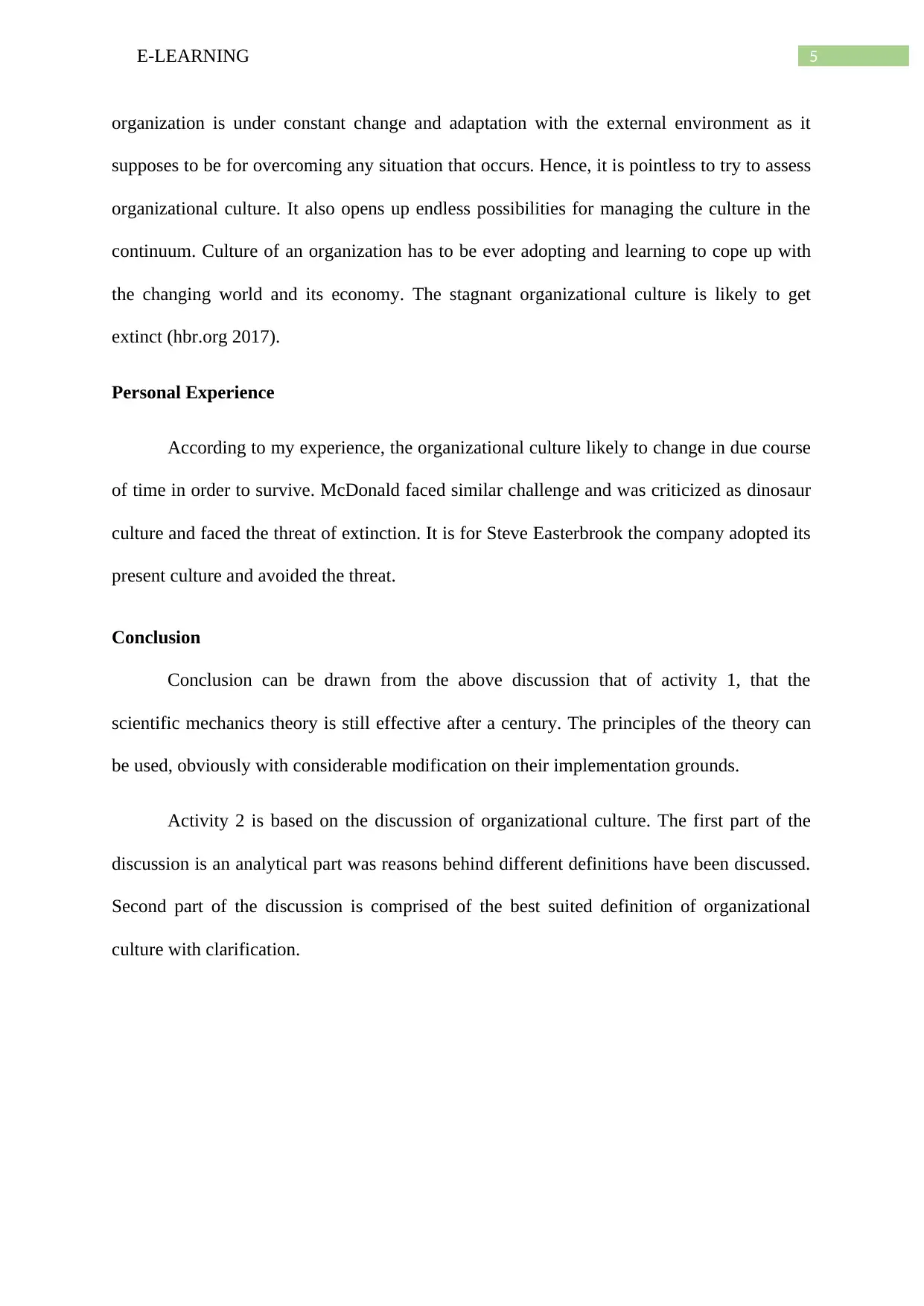
5E-LEARNING
organization is under constant change and adaptation with the external environment as it
supposes to be for overcoming any situation that occurs. Hence, it is pointless to try to assess
organizational culture. It also opens up endless possibilities for managing the culture in the
continuum. Culture of an organization has to be ever adopting and learning to cope up with
the changing world and its economy. The stagnant organizational culture is likely to get
extinct (hbr.org 2017).
Personal Experience
According to my experience, the organizational culture likely to change in due course
of time in order to survive. McDonald faced similar challenge and was criticized as dinosaur
culture and faced the threat of extinction. It is for Steve Easterbrook the company adopted its
present culture and avoided the threat.
Conclusion
Conclusion can be drawn from the above discussion that of activity 1, that the
scientific mechanics theory is still effective after a century. The principles of the theory can
be used, obviously with considerable modification on their implementation grounds.
Activity 2 is based on the discussion of organizational culture. The first part of the
discussion is an analytical part was reasons behind different definitions have been discussed.
Second part of the discussion is comprised of the best suited definition of organizational
culture with clarification.
organization is under constant change and adaptation with the external environment as it
supposes to be for overcoming any situation that occurs. Hence, it is pointless to try to assess
organizational culture. It also opens up endless possibilities for managing the culture in the
continuum. Culture of an organization has to be ever adopting and learning to cope up with
the changing world and its economy. The stagnant organizational culture is likely to get
extinct (hbr.org 2017).
Personal Experience
According to my experience, the organizational culture likely to change in due course
of time in order to survive. McDonald faced similar challenge and was criticized as dinosaur
culture and faced the threat of extinction. It is for Steve Easterbrook the company adopted its
present culture and avoided the threat.
Conclusion
Conclusion can be drawn from the above discussion that of activity 1, that the
scientific mechanics theory is still effective after a century. The principles of the theory can
be used, obviously with considerable modification on their implementation grounds.
Activity 2 is based on the discussion of organizational culture. The first part of the
discussion is an analytical part was reasons behind different definitions have been discussed.
Second part of the discussion is comprised of the best suited definition of organizational
culture with clarification.
⊘ This is a preview!⊘
Do you want full access?
Subscribe today to unlock all pages.

Trusted by 1+ million students worldwide

6E-LEARNING
References
hbr.org. (2017). organizational culture. [online] Available at: https://hbr.org/2013/05/what-
is-organizational-culture [Accessed 18 Aug. 2017].
Heine, S.J., 2015. Cultural Psychology: Third International Student Edition. WW Norton &
Company.
Saler, B., 2015. EB Tylor and the Anthropology of Religion. Marburg Journal of
Religion, 2(1).
wordpress.com. (2017). Ford and Taylorism. [online] Available at:
https://veerpals.wordpress.com/2015/08/10/ford-and-taylorism/ [Accessed 18 Aug. 2017].
Waring, S.P., 2016. Taylorism transformed: Scientific management theory since 1945. UNC
Press Books.
youtube.com. (2017). Ford and Taylor Scientific Management. [online] Available at:
http://www.youtube.com/watch?v=8PdmNbqtDdI [Accessed 18 Aug. 2017].
References
hbr.org. (2017). organizational culture. [online] Available at: https://hbr.org/2013/05/what-
is-organizational-culture [Accessed 18 Aug. 2017].
Heine, S.J., 2015. Cultural Psychology: Third International Student Edition. WW Norton &
Company.
Saler, B., 2015. EB Tylor and the Anthropology of Religion. Marburg Journal of
Religion, 2(1).
wordpress.com. (2017). Ford and Taylorism. [online] Available at:
https://veerpals.wordpress.com/2015/08/10/ford-and-taylorism/ [Accessed 18 Aug. 2017].
Waring, S.P., 2016. Taylorism transformed: Scientific management theory since 1945. UNC
Press Books.
youtube.com. (2017). Ford and Taylor Scientific Management. [online] Available at:
http://www.youtube.com/watch?v=8PdmNbqtDdI [Accessed 18 Aug. 2017].
1 out of 7
Related Documents
Your All-in-One AI-Powered Toolkit for Academic Success.
+13062052269
info@desklib.com
Available 24*7 on WhatsApp / Email
![[object Object]](/_next/static/media/star-bottom.7253800d.svg)
Unlock your academic potential
Copyright © 2020–2025 A2Z Services. All Rights Reserved. Developed and managed by ZUCOL.




